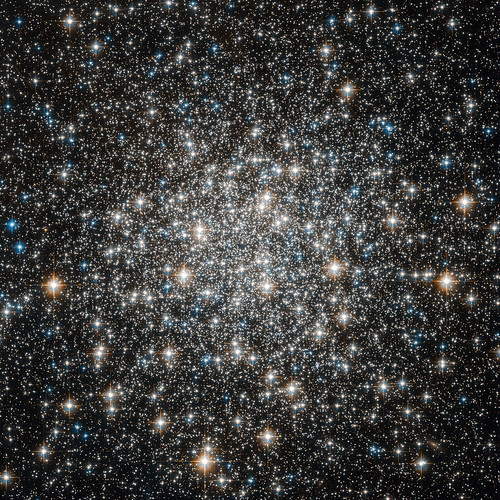 On Starts With a Bang, Ethan Siegel makes headway on his tour of "110 spectacular deep-sky objects" first cataloged by Charles Messier in 1758. Before powerful telescopes were developed, the heavens consisted of the sun, moon, stars, a few bright planets, and the rare passing comet. Comets were actively sought by men like Messier, who one night saw a bright smudge—too ill-defined to be a star—that "neither brightened nor changed position nor altered in appearance over the subsequent nights." He had spotted the beautiful Crab Nebula, an expanding lacework of stardust blown out by a supernova within our own galaxy. Unknown to Messier, some of his nebulae were entirely different galaxies, millions of light years distant, a structure scarcely conceived of in the 18th century (and not proven, on the basis of redshift, until 1912). Other Messier objects turn out to be spectacular star clusters, such as M13, which contains about 300,000 stars "from Sun-like ones down to red dwarfs and white dwarfs, a few blue stragglers (common to globulars), and a few red giant stars" within a diameter of 145 light years. But all these wonders of the universe looked about the same to Messier: things not to confuse with comets, ice orbiting the sun.
On Starts With a Bang, Ethan Siegel makes headway on his tour of "110 spectacular deep-sky objects" first cataloged by Charles Messier in 1758. Before powerful telescopes were developed, the heavens consisted of the sun, moon, stars, a few bright planets, and the rare passing comet. Comets were actively sought by men like Messier, who one night saw a bright smudge—too ill-defined to be a star—that "neither brightened nor changed position nor altered in appearance over the subsequent nights." He had spotted the beautiful Crab Nebula, an expanding lacework of stardust blown out by a supernova within our own galaxy. Unknown to Messier, some of his nebulae were entirely different galaxies, millions of light years distant, a structure scarcely conceived of in the 18th century (and not proven, on the basis of redshift, until 1912). Other Messier objects turn out to be spectacular star clusters, such as M13, which contains about 300,000 stars "from Sun-like ones down to red dwarfs and white dwarfs, a few blue stragglers (common to globulars), and a few red giant stars" within a diameter of 145 light years. But all these wonders of the universe looked about the same to Messier: things not to confuse with comets, ice orbiting the sun.
No Mistaking Astronomical Objects
"It is the highest form of self-respect to admit our errors and mistakes and make amends for them. To make a mistake is only an error in judgment, but to adhere to it when it is discovered shows infirmity of character." -Dale Turner
“I recognize my limits, but when I look around I realise I am not living, exactly, in a world of giants.” -Giulio Andreotti
“Men... have had the vanity to pretend that the world creation was made for them, whilst in reality the whole creation does not suspect their existence.” -Camille Flammarion
"It is by going down into the abyss that we recover the treasures of life. Where you stumble, there lies your treasure." -Joseph Campbell